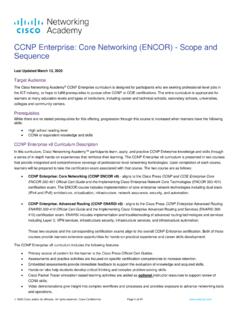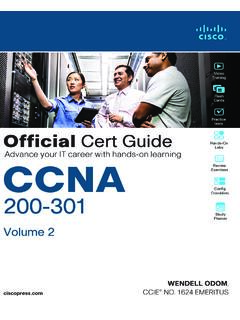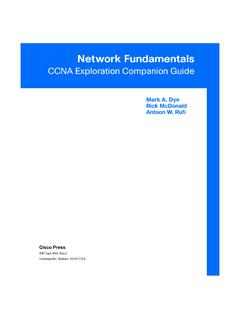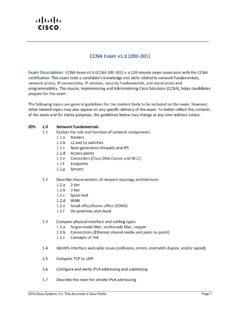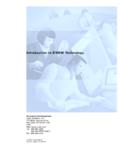Transcription of Introduction to Networks
1 Cisco PressCisco Networking AcademyIntroduction to NetworksCompanion Guide (CCNAv7)ii Introduction to Networks Companion Guide (CCNAv7) Introduction to Networks Companion Guide (CCNAv7)Cisco Networking AcademyCopyright 2020 Cisco Systems, by: Cisco PressAll rights reserved. No part of this book may be reproduced or transmitted in any form or by any means, electronic or mechanical, including photocopying, recording, or by any information storage and retrieval system, without written permission from the pub-lisher, except for the inclusion of brief quotations in a of Congress Control Number: 2020935402 ISBN-13: 978-0-13-663366-2 ISBN-10: 0-13-663366-8 Warning and DisclaimerThis book is designed to provide information about the Cisco Networking Academy Introduction to Networks (CCNAv7) course.
2 Every effort has been made to make this book as complete and as accurate as possible, but no warranty or fitness is information is provided on an as is basis. The authors, Cisco Press, and Cisco Systems, Inc. shall have neither liability nor responsibility to any person or entity with respect to any loss or damages arising from the information contained in this book or from the use of the discs or programs that may accompany opinions expressed in this book belong to the author and are not necessarily those of Cisco Systems, AcknowledgmentsAll terms mentioned in this book that are known to be trademarks or service marks have been appropriately capitalized. Cisco Press or Cisco Systems, Inc., cannot attest to the accuracy of this information. Use of a term in this book should not be regarded as affect-ing the validity of any trademark or service and/or its respective suppliers make no representations about the suitability of the information contained in the documents and related graphics published as part of the Editor-in-ChiefMark TaubAlliances Manager, Cisco PressArezou GolDirector, ITP Product ManagementBrett BartowSenior EditorJames ManlyManaging EditorSandra SchroederDevelopment EditorChristopher ClevelandSenior Project EditorTonya SimpsonCopy EditorKitty WilsonTechnical EditorBob VachonEditorial AssistantCindy TeetersCover DesignerChuti PrasertsithCompositioncodeMantraIndexerE rika MillenProofreaderAbigail Manheim iiiservices for any purpose.
3 All such documents and related graphics are provided as is without warranty of any kind. Microsoft and/or its respective suppliers hereby disclaim all warranties and conditions with regard to this information, including all warranties and conditions of merchantability, whether express, implied or statutory, fitness for a particular purpose, title and non-infringement. In no event shall Microsoft and/or its respective suppliers be liable for any special, indirect or consequential damages or any damages whatsoever resulting from loss of use, data or profits, whether in an action of contract, negligence or other tortious action, arising out of or in connection with the use or performance of information available from the documents and related graphics contained herein could include technical inaccuracies or typographical errors.
4 Changes are periodically added to the information herein. Microsoft and/or its respective suppliers may make improvements and/or changes in the product(s) and/or the program(s) described herein at any time. Partial screen-shots may be viewed in full within the software version and Windows are registered trademarks of the Microsoft Corporation in the and other coun-tries. Screenshots and icons reprinted with permission from the Microsoft Corporation. This book is not sponsored or endorsed by or affiliated with the Microsoft and the Cisco logo are trademarks or registered trademarks of Cisco and/or its affiliates in the and other countries. To view a list of Cisco trademarks, go to this URL: Third party trademarks mentioned are the property of their respective owners. The use of the word partner does not imply a partnership relationship between Cisco and any other company.
5 (1110R)Americas HeadquartersCisco Systems, Jose, CA Asia Pacific HeadquartersCisco Systems (USA) Pte. HeadquartersCisco Systems International BV Amsterdam, The NetherlandsCisco has more than 200 offices worldwide. Addresses, phone numbers, and fax numbers are listed on the Cisco Website at Introduction to Networks Companion Guide (CCNAv7)About the Contributing AuthorsRick Graziani teaches computer science and computer networking courses at Cabrillo College and University of California, Santa Cruz in Santa Cruz, California. Prior to teaching, Rick worked in the information technology field for Santa Cruz Operation, Tandem Computers, and Lockheed Missiles and Space Corporation, and he served in the Coast Guard. He holds an in computer science and sys-tems theory from California State University, Monterey Bay.
6 Rick also works as a cur-riculum developer for the Cisco Networking Academy Curriculum Engineering team. When Rick is not working, he is most likely surfing at one of his favorite Santa Cruz surf Johnson entered the academic world in 1999, after 10 years as a business owner/operator, to dedicate his efforts to his passion for teaching. He holds both an and an in training and development. He taught ccna courses at the high school level for seven years and has taught both ccna and CCNP courses at Del Mar College in Corpus Christi, Texas. In 2003, Allan began to commit much of his time and energy to the ccna Instructional Support Team, providing services to Networking Academy instructors worldwide and creating training materials. He now works full time for Cisco Networking Academy as Curriculum Lead.
7 VContents at a Glance Introduction xxx Chapter 1 Networking Today 1 Chapter 2 Basic Switch and End Device Configuration 45 Chapter 3 Protocols and Models 85 Chapter 4 Physical Layer 137 Chapter 5 Number Systems 175 Chapter 6 Data Link Layer 203 Chapter 7 Ethernet Switching 233 Chapter 8 network Layer 267 Chapter 9 Address Resolution 297 Chapter 10 Basic Router Configuration 319 Chapter 11 IPv4 Addressing 341 Chapter 12 IPv6 Addressing 397 Chapter 13 ICMP 443 Chapter 14 Transport Layer 461 Chapter 15 Application Layer 507 Chapter 16 network Security Fundamentals 541 Chapter 17 Build a Small network 571 Appendix A Answers to Check Your Understanding Questions 631 Key Terms Glossary 645 Index 669 viiContentsIntroduction xxxChapter 1 Networking Today 1 Objectives 1 Key Terms 1 Introduction ( ) 3 Networks Affect Our Lives ( ) 3 Networks Connect Us ( ) 3No Boundaries ( ) 3 network Components ( ) 4 Host Roles ( ) 4 Peer-to-Peer ( ) 5 End Devices ( ) 6 Intermediary Devices ( ) 6 network Media ( ) 7 network Representations and Topologies ( ) 8 network Representations ( ) 8 Topology Diagrams ( ) 10 Physical Topology Diagrams 10 Logical Topology Diagrams 10 Common Types of Networks ( ) 11 Networks of Many Sizes ( ) 11 LANs and WANs ( ) 12L ANs 13WA N s 14 The Internet ( ) 15 Intranets and Extranets ( ) 16 Internet Connections ( ) 17 Internet Access Technologies ( ) 17 Home and Small Office Internet Connections ( ) 18 Businesses Internet Connections ( ) 19 The Converging network ( ) 20viii Introduction to Networks Companion Guide (CCNAv7)Reliable Networks ( )
8 23 network Architecture ( ) 23 Fault Tolerance ( ) 24 Scalability ( ) 24 Quality of Service ( ) 25 network Security ( ) 26 network Trends ( ) 27 Recent Trends ( ) 28 Bring Your Own Device (BYOD) ( ) 28 Online Collaboration ( ) 28 Video Communications ( ) 29 Cloud Computing ( ) 29 Technology Trends in the Home ( ) 31 Powerline Networking ( ) 31 Wireless Broadband ( ) 32 Wireless Internet Service Providers 32 Wireless Broadband Service 32 network Security ( ) 33 Security Threats ( ) 33 Security Solutions ( ) 34 The IT Professional ( ) 35C C NA ( ) 35 Networking Jobs ( ) 36 Summary ( ) 37 Networks Affect Our Lives 37 network Components 37 network Representations and Topologies 37 Common Types of Networks 37 Internet Connections 38 Reliable Networks 38 network Trends 38 network Security 39 The IT Professional 40 Practice 40 Check Your Understanding Questions 40 ixChapter 2 Basic Switch and End Device Configuration 45 Objectives 45 Key Terms 45 Introduction ( ) 46 Cisco IOS Access ( ) 46 Operating Systems ( ) 46 GUI ( ) 47 Purpose of an OS ( ) 48 Access Methods ( ) 49 Terminal Emulation Programs ( ) 50 IOS Navigation ( ) 52 Primary Command Modes ( ) 52 Configuration Mode and Subconfiguration Modes ( ) 53 Navigate Between IOS Modes ( ) 54A Note About Syntax Checker Activities ( ) 55 The Command Structure ( ) 56 Basic IOS Command Structure ( ) 56 IOS Command Syntax Check ( )
9 57 IOS Help Features ( ) 58 Hot Keys and Shortcuts ( ) 58 Basic Device Configuration ( ) 61 Device Names ( ) 61 Password Guidelines ( ) 62 Configure Passwords ( ) 63 Encrypt Passwords ( ) 64 Banner Messages ( ) 65 Save Configurations ( ) 66 Configuration Files ( ) 67 Alter the Running Configuration ( ) 68 Capture Configuration to a Text File ( ) 68 Ports and Addresses ( ) 71IP Addresses ( ) 71 Interfaces and Ports ( ) 73x Introduction to Networks Companion Guide (CCNAv7)Configure IP Addressing ( ) 74 Manual IP Address Configuration for End Devices ( ) 75 Automatic IP Address Configuration for End Devices ( ) 76 Switch Virtual Interface Configuration ( ) 77 Verify Connectivity ( ) 78 Summary ( ) 79 Cisco IOS Access 79 IOS Navigation 79 The Command Structure 79 Basic Device Configuration 79 Save Configurations 80 Ports and Addresses 80 Configure IP Addressing 80 Verify Connectivity 80 Practice 81 Check Your Understanding Questions 81 Chapter 3 Protocols and Models 85 Objectives 85 Key Terms 85 Introduction ( ) 86 The Rules ( ) 86 Communications Fundamentals ( ) 86 Communication Protocols ( ) 87 Rule Establishment ( ) 88 network Protocol Requirements ( ) 88 Message Encoding ( ) 89 Message Formatting and Encapsulation ( ) 90 Message Size ( ) 91 Message Timing ( ) 92 Message Delivery Options ( ) 92A Note About the Node Icon ( ) 94 Protocols 94 network Protocol Overview ( ) 94 network Protocol Functions ( ) 95 Protocol Interaction ( ) 96 xiProtocol Suites ( )
10 97 network Protocol Suites ( ) 97 Evolution of Protocol Suites ( ) 98 TCP/IP Protocol Example ( ) 99 TCP/IP Protocol Suite ( ) 99 Application Layer 101 Transport Layer 102 Internet Layer 102 network Access Layer 103 TCP/IP Communication Process ( ) 103 Standards Organizations ( ) 108 Open Standards ( ) 108 Internet Standards ( ) 108 Electronic and Communications Standards ( ) 111 Reference Models ( ) 111 The Benefits of Using a Layered Model ( ) 112 The OSI Reference Model ( ) 112 The TCP/IP Protocol Model ( ) 114 OSI and TCP/IP Model Comparison ( ) 115 Data Encapsulation ( ) 116 Segmenting Messages ( ) 116 Sequencing ( ) 118 Protocol Data Units ( ) 118 Encapsulation Example ( ) 120De-encapsulation Example ( ) 120 Data Access ( ) 121 Addresses ( ) 121 Layer 3 Logical Address ( ) 122 Devices on the Same network ( ) 123 Role of the Data Link Layer Addresses: Same IP network ( ) 124 Devices on a Remote network ( ) 125 Role of the network Layer Addresses ( ) 125 Role of the Data Link Layer Addresses.










